The Different Possibilities Of Star Trails Photography - Part Two
Hello HIVEs!
This blog was about star trails last Sunday. I showed an example where the images were stitched together by stacking. This is a considerable effort, both during the shooting and even more during the post-processing of the images.
Here is the link to the post...
Part two follows today, using other techniques that show a slightly simpler method of capturing star trails.
Heute folgt Teil zwei, in dem andere Techniken angewendet werden, die eine etwas einfachere Methode zeigen, Sternspuren einzufangen.

GoPro HERO12 Black
ISO 800; 15mm; ƒ2.5; 10s
For the first two pictures shown, I used a GoPro 12 on a small Gorillapod. This camera became my constant companion. The GOPRO HERO 12 action camera is not just about action 😉 I used this camera to record light painting performances as videos or to record star trails. The camera software provides programs for both. This makes it possible to capture usable images with just a few settings. The recording principle is comparable to the LiveComposite of the OM cameras. The recorded individual images are stacked in the camera to form an image or processed into a film sequence.
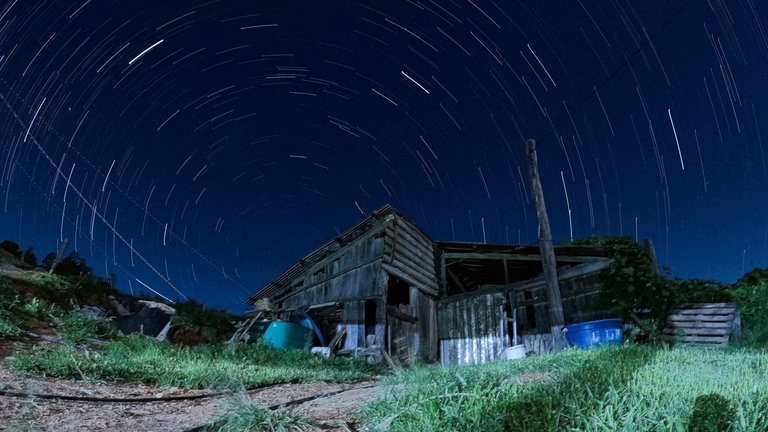
GoPro HERO12 Black
ISO 800; 15mm; ƒ2.5; 10s
Basically, the alignment of the camera to the direction of the sky plays a major role in the composition of the image. I usually try to place the center of the rotating stars centrally above the object depicted.
The two images above were taken in Brazil, in the southern hemisphere. The Southern Cross is located in the immediate vicinity of the constellation Centaur. This serves as an orientation aid in the southern hemisphere.
The special feature of this constellation lies in its “pointer” function, as there is no southern pole star to orient oneself by.
The 4.5-fold extension of the longer bar in the Southern Cross leads approximately to the point around which the southern starry sky appears to rotate.
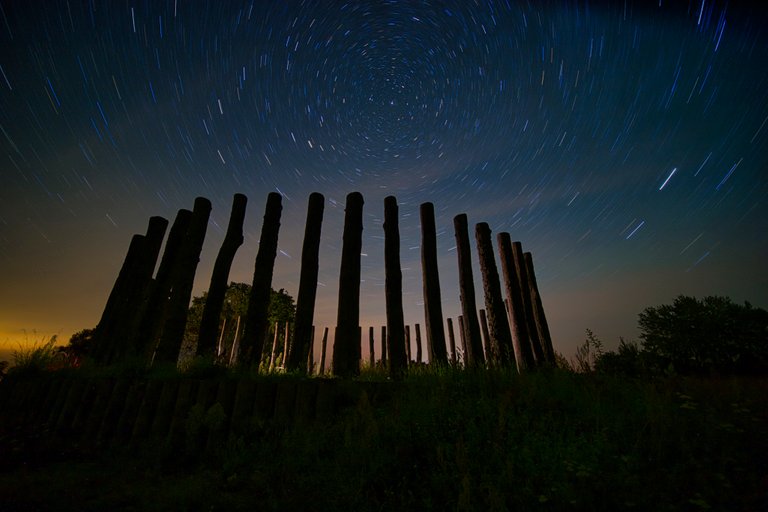
Canon EOS 6D Mark II
LAOWA 12mm
ISO100, 12mm, f2.8, 1242s
Click here to see the making-of
In the northern hemisphere, the starry sky appears to revolve around Polaris. This can be located by extending the imaginary line connecting the two bright stars of the rear axis of the Big Dipper by a factor of five.
But there is an even easier way to find the poles. The PhotoPills app. If you select the “Night AR” menu, the night sky is shown on the display. Now all you have to do is hold the smartphone towards the sky and turn until you have found the pole. The advantage: you can also see the foreground, which is captured by the camera. This allows you to plan an image precisely.
The example above shows the alignment of the camera to the North Star. The stars draw circles in the sky. The image below shows an orientation to the east. The stars “rain” diagonally through the image.
Es gibt aber noch einen denkbar einfacheren Weg die Pole zu finden. Die App PhotoPills. Wählt man das Menü "Nacht-AR", wird der Nachthimmel auf dem Display dargestellt. Jetzt muss man das Smartphone nur noch in Richtung Himmel halten und sich solange drehen, bis man den Pol gefunden hat. Der Vorteil: man sieht auch den Vordergrund, der durch die Kamera aufgenommen wird. Dadurch kann man ein Bild präzise planen.
Das Beispiel oben zeigt die Ausrichtung der Kamera auf den Polarstern. Die Sterne ziehen Kreise am Himmel. Das Bild unten zeigt eine Ausrichtung nach Osten. Die Sterne "Regnen" schräg durch das Bild.
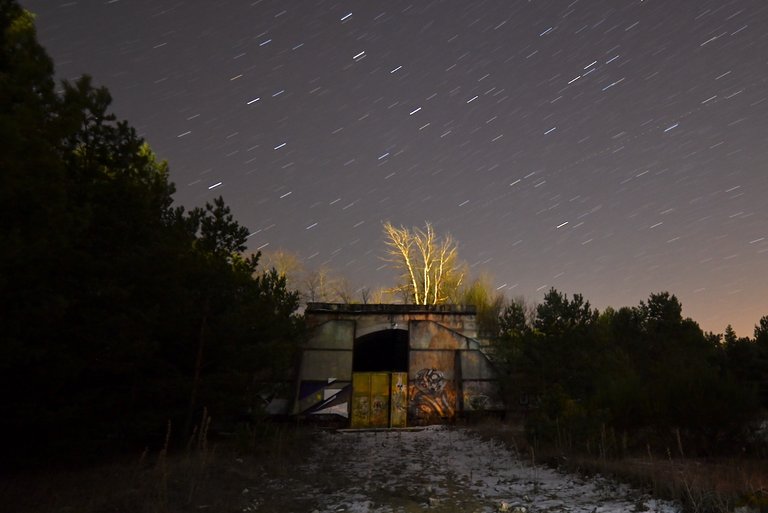
NIKON Z 5
CANON EF16-35mm ƒ4L IS USM
ISO 1250; 16mm; ƒ8; 344s
Another way to record star trails is to take long exposures. The camera is operated in bulb mode. The exposure time here is 20 - 60 minutes. However, there is a risk that the foreground will be overexposed or that the image will become unusable due to the light of a passing vehicle, for example. You should therefore choose a location with as little light smog as possible. I recommend “Lightpollution” as an app for planning. Under a full moon, the foreground very quickly becomes too bright. Another disadvantage is the image noise caused by the long exposure. Depending on the type of camera, this can ruin the image.
Images 3-6 serve as an example of long exposure without stacking.
Als Beispiel für Langzeitbelichtung ohne Stacking dienen die Bilder 3-6.
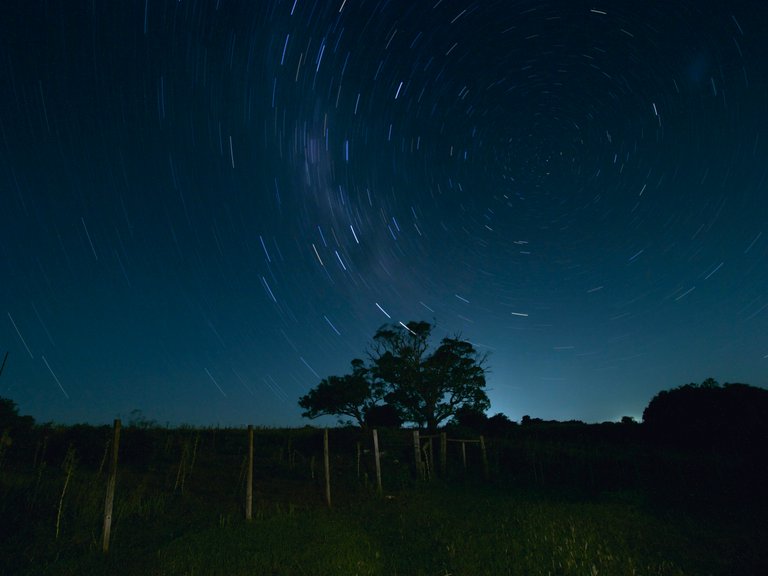
OLYMPUS E-M1MarkII
LAOWA D-Dreamer 12mm F2.8
ISO64, f4, 1400 Sec.
Click here to see the making-of
Conclusion: Photo stacking from images with high-quality equipment naturally produces better results. This is important for print products. For starters, simple methods are often enough to create a wow effect for the viewer. I can highly recommend this as a starting point.
Did you like the post? Then follow me! I'll be publishing a story every Sunday about light painting, astrophotography or photographing with invisible light. So stay tuned!
Hat dir der Post gefallen? Dann folge mir! Ich werde jeden Sonntag eine Story veröffentlichen, bei der es über Lightpainting, Astrofotografie oder das Fotografieren mit unsichtbaren licht geht. Also bleib dran!

Canon EOS 6D Mark II
LAOWA 12mm f2.8
ISO 800; 12mm; ƒ11; 843s
Click here to see the making-of
What Is Light Painting?
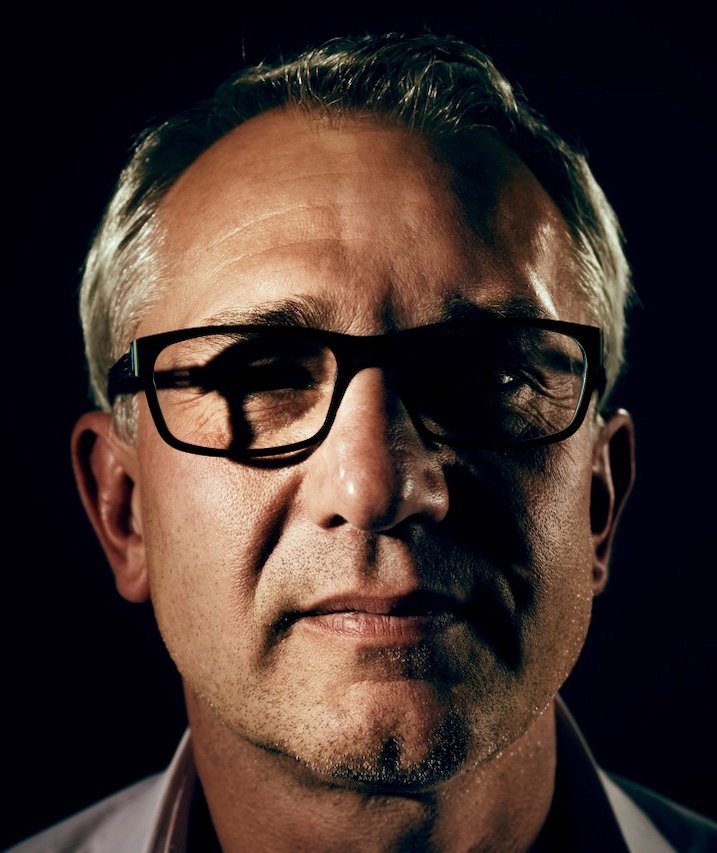
CandelART

WE ARE LIGHT PAINTERS
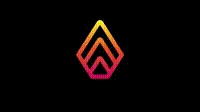
To help and support the LightPainters community here on Hive I would appreciate your delegation of HivePower. Any amount is appreciated. It does not require much to get started, we are happy for any gesture. @lightpainters
How to delegate?
Delegate 50HivePower, [50HP]
Delegate 250HivePower, [250HP]
Delegate 500HivePower, [500HP]
Delegate 1000HivePower, [1000HP]
All the Hive Power will help to upvote the artist's contribution as part of the LightPainters community.
Love the detailed explanation on these! Thanks for the info.
You're welcome!
beautiful atmosphere
Thanks 😊
https://x.com/lee19389/status/190389194787540175
#hive #posh
I was most impressed by the gopro, from which I did not expect such a result at all.
Yes, this little thing can do a lot. It's not a professional tool, but it's kind of cool and fits in any trouser pocket.
Certainly, many professional photographers or videographers I know use smaller and more convenient devices.
!LOL
Posted using Hive Images
lolztoken.com
The corner—they’re usually 90 degrees.
Credit: reddit
@candelart, I sent you an $LOLZ on behalf of hivephoto
(2/10)
Farm LOLZ tokens when you Delegate Hive or Hive Tokens.
Click to delegate: 10 - 20 - 50 - 100 HP